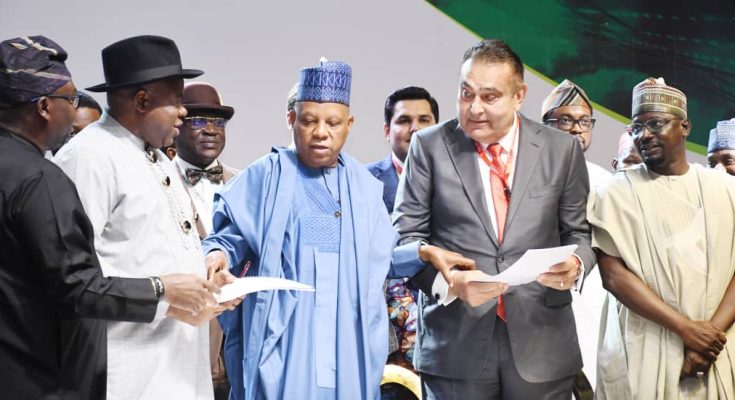Can this be true?
When Nigeria announced that it could unlock $410 billion in renewable energy investment by 2060, many observers cheered. Finally, it seemed, Africa’s largest economy was making an ambitious pivot toward clean energy and away from its overreliance on oil.
But beneath the optimism lies an uncomfortable question: is this genuine progress, or just another grand political promise designed to attract funds and headlines?
A Familiar Story: Big Numbers, Fading Results
Nigeria has made similar pronouncements before. In 2021, the government launched its Energy Transition Plan (ETP), a detailed roadmap toward net-zero emissions by 2060. It estimated that $410 billion would be required over four decades to overhaul the power sector from grid expansion to renewable manufacturing.
The plan was praised globally. But three years later, the tangible results are modest. Nigeria’s renewable energy capacity still accounts for less than 20% of its electricity mix, mostly hydropower. Solar, wind, and biomass the new stars of Africa’s green transition remain underdeveloped.
Foreign direct investment (FDI) in Nigeria’s energy sector fell from around $2.2 billion in 2019 to less than $1 billion in 2023, according to UNCTAD data. While there are isolated projects like the $200 million mini-grid partnership and a few private solar plant deals they hardly add up to a multi-billion-dollar green rush.
So, if the investment hasn’t arrived yet, where are the billions being unlocked from?
Funding vs. Investment
Let’s separate the two concepts.
- Funding is what governments receive grants, loans, or pledges often from development partners or climate finance institutions.
- Investment is what private companies actually spend to build infrastructure, factories, or generation assets.
Nigeria has received several funding pledges from organizations such as the World Bank, the African Development Bank (AfDB), and the Sustainable Energy Fund for Africa (SEFA). These include small but symbolic amounts:
- $750 million for grid expansion and energy access projects (World Bank, 2023)
- $200 million for renewable mini-grids (joint government-private partnership, 2025)
- $100 million from SEFA for early-stage clean energy financing
But these are funding pledges, not investments.
Actual private investment in renewable energy manufacturing such as solar panel assembly plants, battery factories, or local component production remains below $500 million total, according to estimates from the Renewable Energy Association of Nigeria (REAN).
In other words, the “billions” haven’t started flowing yet.
Why Investors Hesitate
For investors, Nigeria presents both opportunity and uncertainty.
1. Policy inconsistency
Energy reforms often shift with every administration. Investors remember the sudden changes in tariff rules, forex restrictions, and opaque subsidy programs. Clean energy projects depend on long-term clarity and Nigeria’s policy environment rarely offers that.
2. Infrastructure bottlenecks
Even if factories were built, poor roads, ports, and power supply make logistics and operations expensive. Ironically, you need reliable electricity to build renewable energy components.
3. Bureaucratic red tape
Investors frequently cite Nigeria’s regulatory hurdles and slow approval processes. It can take months to register clean-energy firms or import equipment.
4. Financial risk
High interest rates and currency depreciation have made local project financing nearly impossible. Without government-backed guarantees, investors face unpredictable exchange rate losses.
These realities explain why multinational clean-energy companies have invested more aggressively in South Africa, Kenya, and Egypt, where renewable frameworks and incentives are clearer.
The Political Side Optics vs. Outcomes
Nigeria’s $410bn headline fits a familiar pattern: governments in Africa announcing big, round numbers that sound good to development partners.
It’s the language of “transformative ambition” impressive for global climate conferences but often disconnected from ground realities.
Such announcements help secure international attention and concessional funding, which governments can later repackage as domestic “achievements.” A billion-dollar pledge might become a photo opportunity, even if the actual disbursement is a fraction of that amount.
That doesn’t mean the government’s intentions are bad. But it does mean we should view the $410bn figure not as secured money, but as a wish list an estimate of what Nigeria needs over 40 years, not what it has.
A Softer Way to Get Money?
Many experts quietly admit that energy transition narratives have become a diplomatic tool. Countries use them to justify foreign borrowing, debt relief, or grant requests from richer nations and global climate funds.
In that sense, yes the $410bn figure could partly be a “soft way” to attract new money.
Nigeria isn’t alone. Similar strategies appear across the continent:
- Egypt’s $40bn hydrogen plan (2023)
- South Africa’s $8.5bn Just Energy Transition deal (2021)
- Kenya’s $2bn green bond framework
All these announcements make sense strategically they help African countries position themselves for green financing. But only a fraction of the funds end up in real, ground-level projects.
The Opportunity Beneath the Politics
Yet, dismissing the plan entirely would be unfair. Nigeria does have genuine potential to become a renewable powerhouse. Its population of 230 million ensures high domestic energy demand. Its sunlight exposure is among the best in the world. And its youth population is tech-savvy and entrepreneurial.
If policymakers can cut through bureaucracy, build transparent procurement systems, and incentivize local manufacturing, Nigeria can truly unlock large-scale investment, maybe not $410 billion, but certainly tens of billions over the next decade.
Also read: Nigeria Unlocking $410bn to Become Africa’s Renewable Energy Hub
What Nigeria Needs to Prove
- Transparent reporting: Publish an annual renewable investment tracker — who invested, how much, and where the money went.
- Stable policies: Offer investors confidence through consistent tariffs and currency stability.
- Local financing: Strengthen development banks and green funds to offer low-interest loans for clean projects.
- Anti-corruption safeguards: Create independent oversight for all climate and energy funds.
Without these, even the best announcements will remain empty words.



